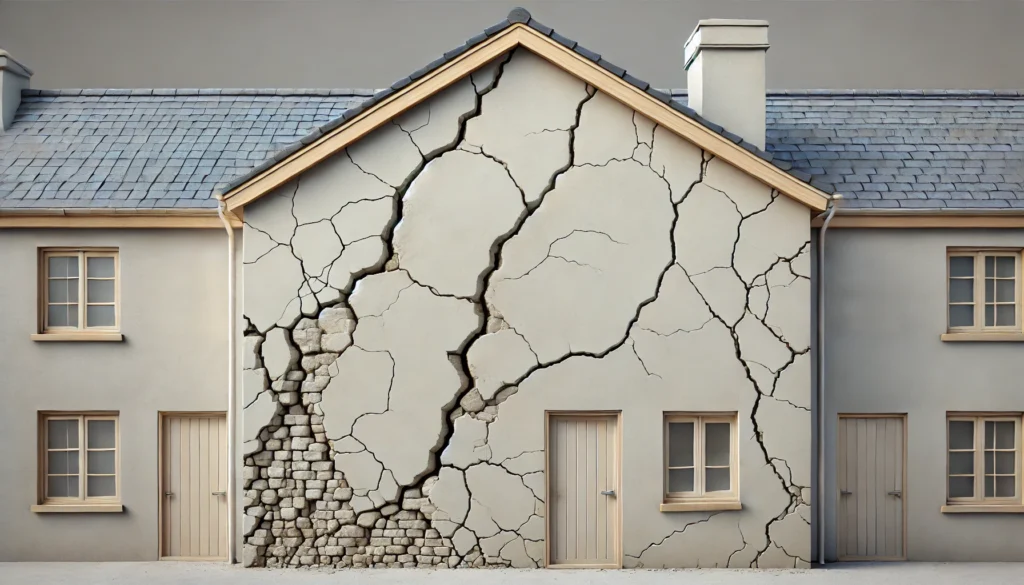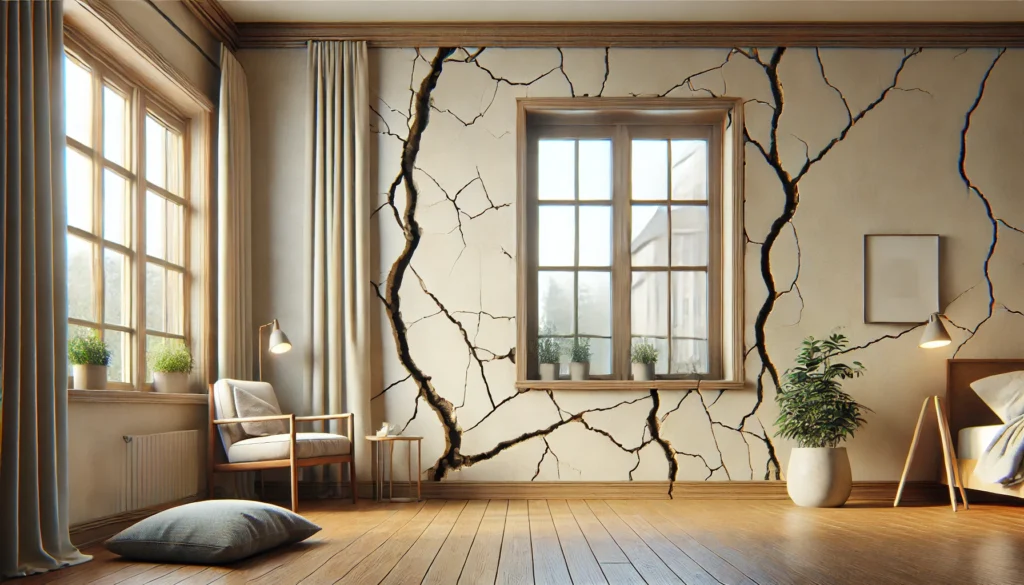Cracks in walls are a common concern for homeowners, building managers, and property investors. Whether it’s a minor cosmetic issue or an indication of something more serious, understanding the nature of these cracks is essential to ensure the structural integrity of a building. This blog post will cover everything you need to know about cracks in walls, including their causes, different types, and the most effective ways to fix them.
What Causes Cracks in Walls?
Cracks in walls can be caused by a variety of factors, ranging from normal wear and tear to more severe structural problems. Understanding the root cause is key to determining the appropriate solution. Here are some common causes:
1. Foundation Movement
One of the most common causes of cracks in walls is the movement of the foundation. Foundations can shift due to changes in soil moisture, poor construction, or natural settling. As the foundation moves, it can place stress on the walls, leading to cracks.
2. Thermal Expansion and Contraction
Temperature changes can cause materials to expand and contract. For example, during the day, heat causes the building materials to expand, while at night, cooler temperatures cause them to contract. This ongoing cycle can eventually lead to cracks in both interior and exterior walls.
3. Moisture and Water Damage
Excess moisture or water damage from leaks can weaken the structural materials in walls, leading to cracks. Water infiltration from heavy rains, broken pipes, or improper drainage can erode the materials and create visible cracks over time.
4. Poor Construction Practices
Improper construction methods, such as using substandard materials or insufficient structural support, can lead to cracking. If the building wasn’t constructed to standard, the walls may not be able to withstand normal stressors, resulting in cracking over time.
5. Natural Disasters
Events like earthquakes, floods, or even strong winds can cause structural stress, leading to wall cracks. In regions prone to seismic activity, walls can crack as a result of shifting ground forces.
6. Aging of Building Materials
As buildings age, the materials used in construction naturally degrade and lose their structural integrity. This natural aging process can lead to cracks forming in walls.
Types of Wall Cracks and What They Mean
Not all wall cracks are created equal. Understanding the different types of cracks can help identify the underlying cause and guide the appropriate fix.
1. Hairline Cracks
- Appearance: Thin, shallow cracks resembling a hair’s width.
- Causes: Often caused by minor foundation settling, normal shrinkage of construction materials, or thermal expansion.
- Severity: Hairline cracks are typically cosmetic and not a major cause for concern. However, if they widen over time, they may indicate a more serious problem.
2. Vertical Cracks
- Appearance: Cracks running straight up and down the wall.
- Causes: Vertical cracks are usually caused by minor foundation movement or settling.
- Severity: While often not serious, vertical cracks should be monitored. If they grow wider, they could signal significant foundation issues that require professional inspection.
3. Horizontal Cracks
- Appearance: Cracks running parallel to the ground, along the wall.
- Causes: Horizontal cracks can be a sign of serious structural problems, including foundation movement, soil pressure, or water damage.
- Severity: These are more concerning than vertical cracks and usually indicate significant pressure on the wall. They should be inspected by a structural engineer immediately.
4. Diagonal Cracks
- Appearance: Cracks slanting diagonally across the wall.
- Causes: Diagonal cracks can result from uneven foundation settling or shifting.
- Severity: Diagonal cracks should be addressed promptly, as they often indicate uneven foundation movement and can worsen over time.
5. Step Cracks
- Appearance: Cracks that follow a staircase pattern, typically seen in brick or block walls.
- Causes: Step cracks are commonly caused by foundation movement, particularly differential settling where one part of the foundation sinks more than another.
- Severity: These cracks often indicate structural issues with the foundation and should be evaluated by a professional.
6. Settlement Cracks
- Appearance: Cracks that appear shortly after a building is constructed, often found near windows, doors, or corners.
- Causes: These cracks result from the natural settling of the building over time.
- Severity: Settlement cracks are common in new buildings and are usually minor. However, if they continue to grow or change, they may point to deeper structural problems.
How to Fix Cracks in Walls
Fixing cracks in walls depends on the type and severity of the crack. Here’s a step-by-step guide on how to approach different types of cracks:
1. Hairline and Cosmetic Cracks
- Tools Needed: Paint scraper, joint compound, sandpaper, primer, and paint.
- Steps:
- Clean the area around the crack to remove any loose material.
- Use a paint scraper to widen the crack slightly, ensuring the filler can penetrate.
- Apply a layer of joint compound to the crack, pressing it in with a putty knife.
- Once dry, sand the area smooth and apply primer before repainting.
2. Vertical Cracks
- Tools Needed: Epoxy filler, caulk, and paint.
- Steps:
- Clean the crack and surrounding area.
- Use epoxy filler to fill the crack, as it can bond strongly with the wall material.
- Smooth the area and let it dry.
- Repaint to match the surrounding wall.
3. Horizontal or Diagonal Cracks
- Tools Needed: Structural epoxy, mortar, or professional foundation repair.
- Steps:
- For small horizontal cracks, you can use structural epoxy or mortar to fill the crack.
- Larger horizontal or diagonal cracks should be inspected by a professional, as they often indicate significant structural issues that may require foundation reinforcement.
4. Step Cracks
- Tools Needed: Mortar, sealant, and professional evaluation.
- Steps:
- Clean the crack and apply fresh mortar to the affected areas.
- Use a sealant to prevent moisture from entering the crack.
- Seek professional advice if the step cracks are extensive, as they could require foundation repair.
5. Severe Structural Cracks
- Professional Repair: In cases of severe cracking, particularly those involving horizontal or diagonal cracks, you should consult a structural engineer. The foundation may need reinforcement, which can involve techniques like underpinning or wall anchors to stabilize the structure.

Preventing Future Cracks in Walls
Once cracks are repaired, it’s essential to take preventive measures to avoid future issues. Here are some tips to keep your walls crack-free:
1. Monitor Foundation Movement
If your home is located in an area prone to foundation shifting, regular inspections can help catch early signs of movement. Consider using foundation monitoring tools to track any changes over time.
2. Control Moisture Levels
Ensure proper drainage around your property to avoid water damage. Install gutters and downspouts to direct water away from the foundation, and fix any leaks immediately.
3. Maintain Temperature Control
Minimizing extreme temperature fluctuations inside your home can help reduce thermal expansion and contraction, which contributes to cracks. Using insulation and keeping a stable indoor temperature can help.
4. Use Quality Building Materials
If you’re constructing or renovating a home, ensure that high-quality materials and proper construction methods are used. Substandard materials or improper installation can lead to cracking later on.
Pro Inspect Solution: Your Partner in Building Inspection and Structural Assessment
If you’re experiencing cracks in your walls and are concerned about the structural integrity of your property, Pro Inspect Solution can help. As a leading provider of property and building inspections in Malaysia, Pro Inspect Solution specializes in structural assessments, ensuring your home or building is safe and sound. Their team of experts can identify the root cause of cracks and recommend the best solutions to restore stability. Visit Pro Inspect Solution for more information and to schedule an inspection today.
Conclusion
Cracks in walls are a common issue that can range from minor cosmetic concerns to serious structural problems. Understanding the different types of cracks—whether hairline, vertical, horizontal, diagonal, or step cracks—can help you assess the severity and underlying cause. While some cracks are harmless and a result of normal settling or thermal expansion, others may indicate more significant issues like foundation movement or water damage.
Early detection and appropriate intervention are crucial to prevent further damage. In cases where cracks seem serious, especially those wider than 3 mm or rapidly expanding, it’s always wise to consult a structural engineer or a professional inspection service like Pro Inspect Solution. Regular inspections and preventive measures, such as controlling moisture levels, ensuring proper drainage, and using quality materials during construction, can also help avoid future wall cracking.
FAQs about Cracks in Walls
Q1: When should I worry about cracks in walls?
You should be concerned about cracks if they are wider than 3 mm, appear suddenly, or continue to widen over time. Cracks that run horizontally, diagonally, or in a stair-step pattern could indicate serious structural issues, especially if they are accompanied by signs of foundation movement or water damage. In such cases, it’s best to consult a structural engineer for a professional assessment.
Q2: How do you tell if a crack in a wall is serious?
A serious crack is typically wider than 3 mm, runs horizontally or diagonally, or shows a step pattern in brick or block walls. Other signs include cracks that appear suddenly or continue to grow over time. Additionally, cracks near windows, doors, or along the foundation might point to underlying structural problems. It’s important to monitor such cracks closely and seek expert advice if they worsen.
Q3: What is the reason for wall cracks?
Wall cracks can occur due to several reasons, including foundation settling, thermal expansion, poor construction practices, water damage, or natural disasters like earthquakes. Other factors like soil movement, temperature fluctuations, and aging building materials also contribute to wall cracking. Understanding the cause helps determine the best repair approach.
Q4: Do cracks indicate a structural problem?
Not all cracks indicate structural problems, but some do. Vertical and hairline cracks are often cosmetic and result from minor foundation settling or material shrinkage. However, horizontal, diagonal, or step cracks can indicate more severe foundation or structural issues. If you notice these types of cracks, it’s important to have them evaluated by a structural engineer or building inspector.
Q5: Is it safe to stay in a house with cracks?
For minor cosmetic cracks, it is generally safe to stay in the house. However, if the cracks are large, expanding, or associated with other signs of structural damage (like uneven floors or sticking doors), it may be unsafe. In cases of severe cracks, especially those indicating foundation problems, it’s essential to get a professional assessment to ensure the safety of the building.
Q6: How much wall cracking is normal?
Minor hairline cracks, particularly in new buildings, are normal as the structure settles. Vertical and small diagonal cracks less than 3 mm wide are common and typically not a cause for concern. However, cracks larger than this, especially if they expand or change over time, could signal a more significant issue requiring professional inspection.


